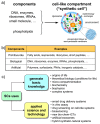Is Research on "Synthetic Cells" Moving to the Next Level?
- PMID: 30587790
- PMCID: PMC6463193
- DOI: 10.3390/life9010003
Is Research on "Synthetic Cells" Moving to the Next Level?
Abstract
"Synthetic cells" research focuses on the construction of cell-like models by using solute-filled artificial microcompartments with a biomimetic structure. In recent years this bottom-up synthetic biology area has considerably progressed, and the field is currently experiencing a rapid expansion. Here we summarize some technical and theoretical aspects of synthetic cells based on gene expression and other enzymatic reactions inside liposomes, and comment on the most recent trends. Such a tour will be an occasion for asking whether times are ripe for a sort of qualitative jump toward novel SC prototypes: is research on "synthetic cells" moving to a next level?
Keywords: artificial cells; autopoiesis; cell-free protein synthesis; complexity; liposomes; microfluidics; numerical modeling; origins of life; protocells; synthetic biology; synthetic cells.
Conflict of interest statement
The author declares no conflict of interest.
Figures








Similar articles
-
Gene Expression Inside Liposomes: From Early Studies to Current Protocols.Chemistry. 2019 Jun 12;25(33):7798-7814. doi: 10.1002/chem.201806445. Epub 2019 Apr 23. Chemistry. 2019. PMID: 30889296 Review.
-
Extrinsic stochastic factors (solute partition) in gene expression inside lipid vesicles and lipid-stabilized water-in-oil droplets: a review.Synth Biol (Oxf). 2018 Jul 27;3(1):ysy011. doi: 10.1093/synbio/ysy011. eCollection 2018. Synth Biol (Oxf). 2018. PMID: 32995519 Free PMC article. Review.
-
Minimal cells: relevance and interplay of physical and biochemical factors.Biotechnol J. 2011 Jul;6(7):850-9. doi: 10.1002/biot.201100079. Epub 2011 Jun 7. Biotechnol J. 2011. PMID: 21648093 Review.
-
Transcription and Translation in Cytomimetic Protocells Perform Most Efficiently at Distinct Macromolecular Crowding Conditions.ACS Synth Biol. 2020 Oct 16;9(10):2797-2807. doi: 10.1021/acssynbio.0c00330. Epub 2020 Oct 5. ACS Synth Biol. 2020. PMID: 32976714 Free PMC article.
-
Bottom-Up Assembly of Functional Intracellular Synthetic Organelles by Droplet-Based Microfluidics.Small. 2020 Jul;16(27):e1906424. doi: 10.1002/smll.201906424. Epub 2020 Feb 20. Small. 2020. PMID: 32078238
Cited by
-
In vitro assembly, positioning and contraction of a division ring in minimal cells.Nat Commun. 2022 Oct 15;13(1):6098. doi: 10.1038/s41467-022-33679-x. Nat Commun. 2022. PMID: 36243816 Free PMC article.
-
Investigating Prebiotic Protocells for A Comprehensive Understanding of the Origins of Life: A Prebiotic Systems Chemistry Perspective.Life (Basel). 2019 Jun 7;9(2):49. doi: 10.3390/life9020049. Life (Basel). 2019. PMID: 31181679 Free PMC article. Review.
-
A Wetware Embodied AI? Towards an Autopoietic Organizational Approach Grounded in Synthetic Biology.Front Bioeng Biotechnol. 2021 Sep 23;9:724023. doi: 10.3389/fbioe.2021.724023. eCollection 2021. Front Bioeng Biotechnol. 2021. PMID: 34631678 Free PMC article. No abstract available.
-
Giant Vesicles Produced with Phosphatidylcholines (PCs) and Phosphatidylethanolamines (PEs) by Water-in-Oil Inverted Emulsions.Life (Basel). 2021 Mar 10;11(3):223. doi: 10.3390/life11030223. Life (Basel). 2021. PMID: 33801936 Free PMC article.
-
Build-a-Cell: Engineering a Synthetic Cell Community.Life (Basel). 2021 Nov 3;11(11):1176. doi: 10.3390/life11111176. Life (Basel). 2021. PMID: 34833052 Free PMC article.
References
LinkOut - more resources
Full Text Sources

